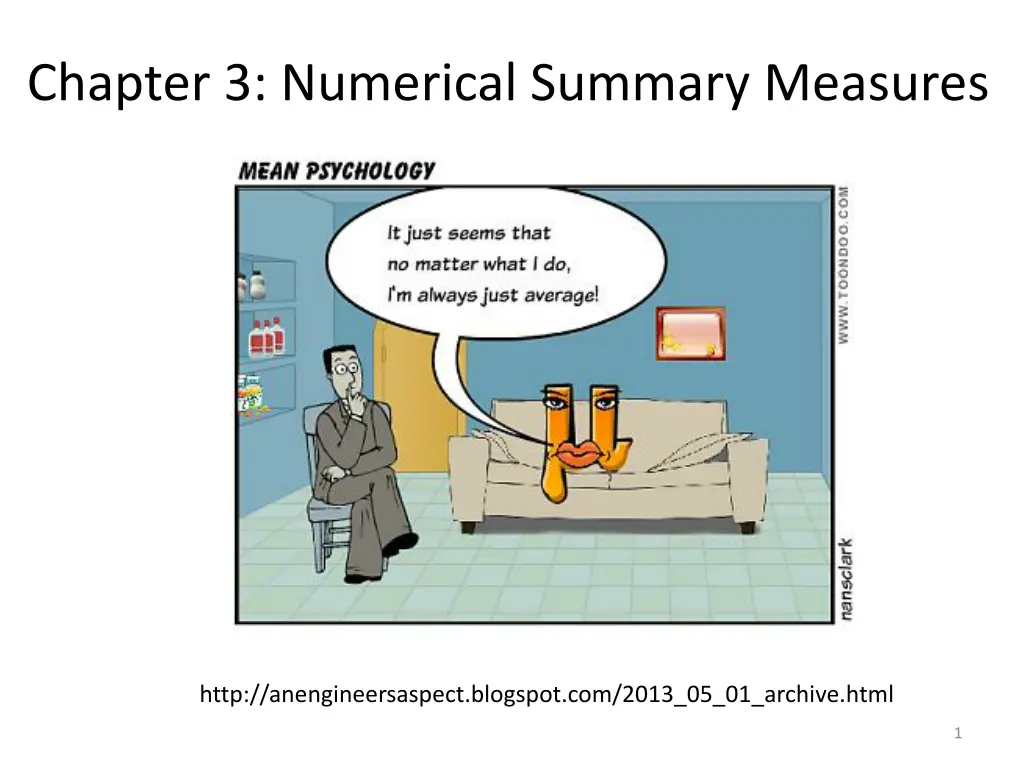
Understanding Numerical Summary Measures in Statistics
Learn about numerical summary measures in statistics, including measures of central tendency, variability, and distribution. Explore concepts such as mean, median, mode, range, variance, standard deviation, quartiles, and more to effectively analyze data sets.
Download Presentation

Please find below an Image/Link to download the presentation.
The content on the website is provided AS IS for your information and personal use only. It may not be sold, licensed, or shared on other websites without obtaining consent from the author. If you encounter any issues during the download, it is possible that the publisher has removed the file from their server.
You are allowed to download the files provided on this website for personal or commercial use, subject to the condition that they are used lawfully. All files are the property of their respective owners.
The content on the website is provided AS IS for your information and personal use only. It may not be sold, licensed, or shared on other websites without obtaining consent from the author.
E N D
Presentation Transcript
Chapter 3: Numerical Summary Measures http://3.bp.blogspot.com/-Hge1B7Ezf8Y/UYFCDQbO5GI/AAAAAAAANEY/Ug7ypc1fOv4/s400/mean+psychology.png http://anengineersaspect.blogspot.com/2013_05_01_archive.html 1
Numerical Summary Measures: Goals Describe the center of a distribution by: mean Median mode Compare the mean and median Describe the measure of spread: range Variance and standard deviation Quartiles Be able to determine which summary statistics are appropriate for a given situation Empirical Rule and introduction to the normal distribution Describe a distribution by a boxplot (five-number summary and outliers) 2
Definition Measures of central tendency indicate where the majority of the data is centered, bunched or clustered. 3
Notation lower case letters, x, y, z indicate the variables. x1, x2, x3, .., xn refers to a set of fixed observations of a variable. n : This is the number of observations in a data set which is called the sample size. 4
Sample Mean ? =??? ?? ???????????? =1 ? ?? ? = population mean Sample --> Latin letters Population --> Greek letters 5
Sample Median, x Procedure 1. Sort n observations from smallest to largest 2. If n is odd, x is the center If n is even, x is the average of the two center observations 6
Mean and Median Mean Median Left skew Right skew Mean Mean Median Median 7
Mode, M The value with the greatest frequency. 8
Variability of Data 1 2 3 -20 -10 0 10 20 Set 1 Set 2 Set 3 -15 -15 -3 -10 -5 -2 -5 -1 -1 0 0 0 5 1 1 10 5 2 15 15 3 9
Measures of Variability Sample range Sample variance (sample standard deviation) Interquartile Range (IQR) 10
Sample Variance 1 2= ? 1 (?? ?)2 ???????? = ?? 2 1 2 1 = ? 1 ?? ?? ? 1 ? 1 (?? ?)2 ???????? ????????? = ??= 2 = population variance 11
Comments for Standard Deviation Variance is used to determine spread for comparisons. s2 = 0 means that all of the observations are the same, normally s > 0 n = 1 s is not resistant to outliers s has the same units of measurement as the original observations 12
Quartiles Q1 Q2 Q3 13
Quartiles - Procedure 1. Sort the values from lowest to highest and locate the median. 2. The first quartile, Q1 is the median of the lower half. a. Compute d1 = n/4 b. If d1 is an integer, then Q1 is the mean of the observations at d1 and d1 + 1 c. If d1 is not an integer, the Q1 is the observation at ?1. 3. The third quartile, Q3 is the median of the upper half. a. Computer d2 = 3n/4. b. Repeat steps 2b and 2c. 14
Outliers After finding the IQR, find the two inner fences (low and high) and the two outer fences (low and high) IFL= Q1 1.5(IQR) OFL= Q1 3(IQR) IFH = Q3 + 1.5 (IQR) mild OFH = Q3 + 3 (IQR) extreme 15
Boxplots Procedure 1. Find Q1, Q3, median and IQR 2. Calculate IFL, IFH, OFL, OFH 3. Draw a central box from Q1 to Q3. Draw a line for the median. 4. Extend lines (whiskers) from the box to the minimum and maximum values that are not outliers. 5. Put in closed circles for mild outliers and open circles for extreme outliers. 16
Choosing Measures of Center and Spread Choices 1. Mean and standard deviation 2. Median and IQR ALWAYS PLOT YOUR DATA! http://freshspectrum.com/wp-content/uploads/2012/09/ Hans-Rosling-Bubble-Plot-Cartoon.jpg 19
Empirical Rule 68-95-99.7 Rule 20
z-score ??=?? ? z-score is a measure of relative standing Given a set of n observations, the sum of the z-scores is 0. ? 21






















